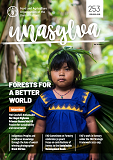
Unasylva
Unasylva is FAO's international journal of forestry and forest industries. Its goal is to bring globally significant developments in forestry to a broad range of readers - policymakers, forest managers, technicians, researchers, students and teachers.
First published in 1947 and produced in English, French, and Spanish editions, Unasylva is FAO’s longest running periodical. Unasylva is diverse and global; each issue, to the extent possible, has authors from every region of the world, and from research institutions, UN agencies, non-governmental organizations and civil society.
FAO offers a free digital subscription. Join the Unasylva mailing list by sending an email to [email protected].
- government officials, particularly in national forest services and the administrative structures responsible for overall agricultural and rural development. This category also includes representatives of the United Nations and its specialized agencies as well as staff of government organizations dealing with forestry;
- non-governmental organizations dealing with forestry at local, national and international levels;
- forestry schools and institutes, including their library users and staff members;
- industrial forestry operators, both government and private;
individual professional foresters, especially those concerned with international forestry.
Subscribe to Unasylva
Join the Unasylva mailing list by sending an email to [email protected].
By subscribing to Unasylva, you are providing consent for FAO’s retention and processing of your personal data, in accordance with the FAO Data Protection and Privacy Notice.Contact

Unasylva 254: Towards more resilient and diverse planted forests
2023
This Unasylva presents novel findings and state-of-the-art information on planted forests. These forests support livelihoods - including through timber production - while also providing ecosystem services, restoring degraded ecosystems, and adapting to and mitigating climate change.

Unasylva 253: Forests for a better world
2022
To coincide with the 50th anniversary of FAO’s Committee on Forestry, this edition of Unasylva showcases ways in which forests are delivering the "four betters" and underscores how forests are crucial for resilient and sustainable agrifood systems in a changing climate.

Unasylva 252: Restoring the Earth - The next decade
2020
This Unasylva issue aims at showcasing forest and landscape restoration (FLR) opportunities and recent developments that have the power to upscale restoration, in order to achieving the Bonn Challenge pledge and other national and international commitments.

Unasylva 251: Forests: nature-based solutions for water
2019
Forested watersheds provide an estimated 75 percent of the world’s accessible freshwater resources, on which more than half the Earth’s people depend for domestic, agricultural, industrial and environmental purposes. Forests therefore, are vital natural infrastructure, and their management can provide “nature-based solutions” for a range of water-related societal challenges.

Unasylva 250: Forests and sustainable cities
2018
Cities need forests. The network of woodlands, groups of trees and individual trees in a city and on its fringes performs a huge range of functions – such as regulating climate; storing carbon; removing air pollutants; reducing the risk of flooding; assisting in food, energy and water security; and improving the physical and mental health of citizens. This edition of Unasylva takes a close look at urban and peri-urban forestry – its benefits, pitfalls, governance and challenges.
